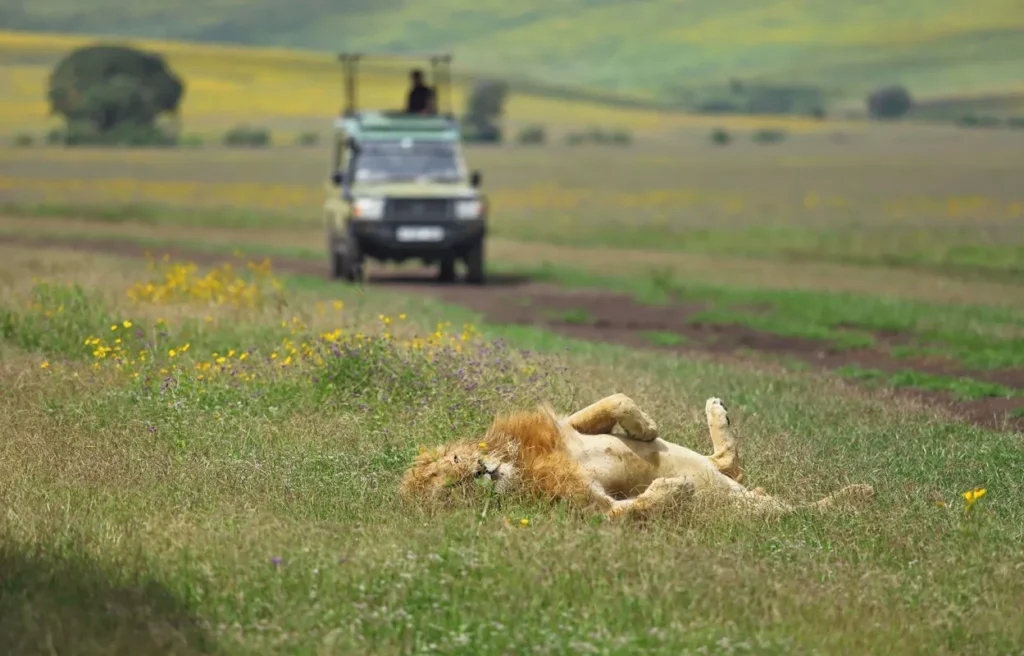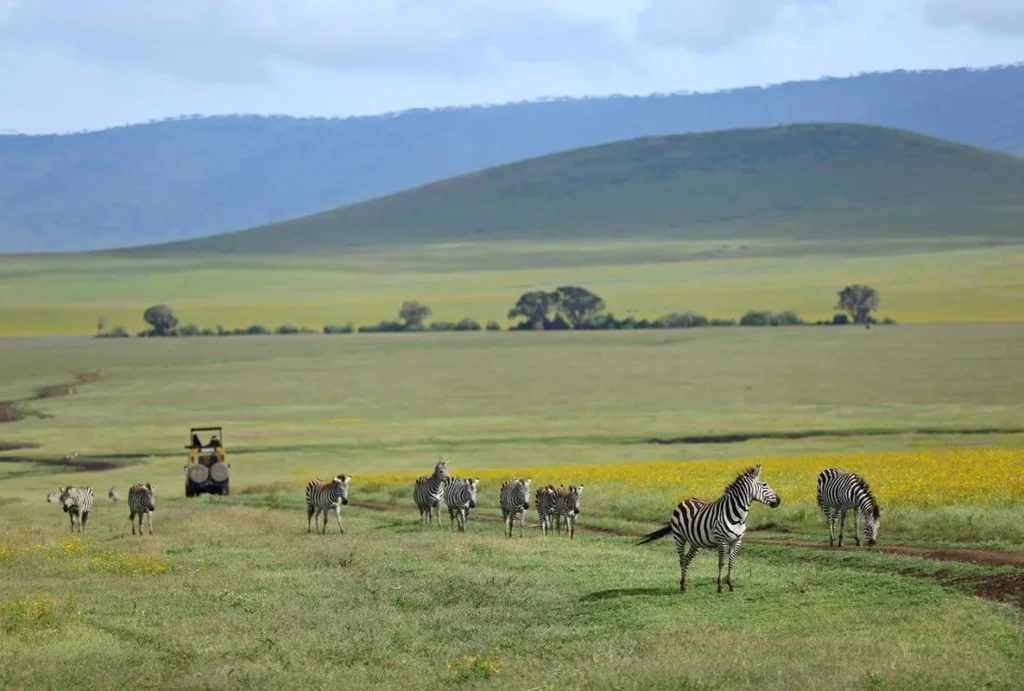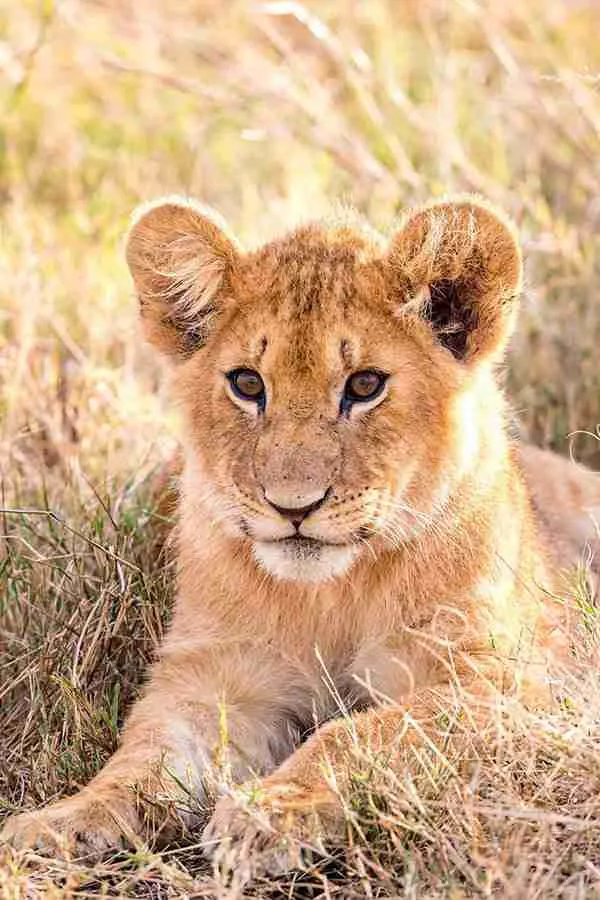Share on:
With its breathtaking landscapes and diverse ecosystems, a safari in Tanzania is an authentic experience, like immersing yourself in a paradise of wildlife. A safari in Tanzania is not simply a journey, but a journey of discovery to be cherished.
Whether you are a safari expert or a first-time visitor, this East African gem will surprise you.

The Great Migration in Serengeti National Park
Serengeti National Park, covering 14,763 km², is Tanzania’s best-known national park and hosts one of the most astonishing natural spectacles on Earth: the Great Migration, the largest movement of animal herds on the planet. It is a constantly moving circular migration of over a million animals (1,000 animals per km²) through the Serengeti-Mara ecosystem. The constant movement of wildebeest columns, flanked by zebras and gazelles, follows a centuries-old route in search of pasture and water. After giving birth in the southern part of the Serengeti in Tanzania, near the Ngorongoro Conservation Area, the animals cross the Serengeti in a clockwise direction and head towards the Masai Mara in Kenya, before returning again towards the end of the year. Along the way, danger is ever-present, as hungry predators such as lions, leopards, cheetahs, hyenas, wild dogs, and crocodiles ensure that only the strongest survive in this natural spectacle.
It’s unclear how migratory grazers know which way to go, but it’s generally believed that their journey is dictated primarily by their response to weather conditions: they follow rain and the growth of new grass. Although there’s no scientific proof, some experts believe the animals react to lightning and distant thunderstorms. It’s even been hypothesized that wildebeest can detect rain from more than 50 km away.
Around January each year, the migration ends its southward journey, moving to the southern Serengeti. Here, the plains are rich in nutritious grass and offer the herds the best conditions for raising newborn calves. This is known as the “calving season,” which extends until March.
In April, after giving birth to their calves, wildebeest herds begin moving northwest toward the cooler grasses of the central Serengeti, attracting thousands of zebras and small herds of antelope. In May, wildebeest herds begin to form near the Moru Kopjes and extend for several kilometers. By late May, male wildebeests engage in head-to-head combat, marking the beginning of the mating season. Gradually, the movement picks up pace, and the wildebeest begin to mass in the western corridor of the Serengeti. By this time of year, Ubuntu Migration Camp will have relocated to monitor the migration and provide access to observe the wildebeest crossing the Grumeti River. The herds form in large numbers along the river pools and channels, which they must cross to continue their journey. It may not be as spectacular as the famous Mara crossing, but there are still enough wildebeest to provide the Grumeti crocodiles with a veritable feast. It’s worth noting that May is low season in Ubuntu. Safaris during this time offer excellent value, as tourist numbers in the Serengeti are relatively low, but wildlife sightings remain excellent.
Gradually, the movement gains momentum and the wildebeest begin to mass in the western corridor of the Serengeti adjacent to the pools and channels of the Grumeti River, which they must cross to continue their journey.
The dry season begins in June, and wildebeests concentrate on the southern banks of the Grumeti River. Around July, hundreds of thousands of wildebeest, zebras, and antelopes continue north along the park’s western edge toward an even more dangerous barrier: the Mara River in the northern Serengeti. Mara River crossings are probably one of the most exciting wildlife events on Earth. They typically begin in early July, but timing depends on nature.
In August, the herds faced the challenge of crossing the Mara River and are scattered between the northern Masai Mara region and the northern Serengeti. In years when the river is in flood, the panic and confusion that ensues during the crossing, combined with lurking predators and raging currents, can cause significant losses of wildebeest and other animals. But even in years when the water flows relatively gently, crocodiles do their part, not to mention the lions and other large predators that patrol the banks, ready to ambush any wildebeest that manages to reach the other side. The crossings occur at various points.
Between September and October, the main chaos ended and the migratory columns gradually moved eastward. However, the wildebeest will once again have to brave the heavy waters of the Mara River on their return journey south.
After the brief rains of late October and early November, the wildebeest head toward the eastern edges of the Serengeti, passing through the Namiri Plains, an area known for its exceptional cheetah sightings. By December, wildebeest have spread throughout the eastern and southern reaches.
In the early months of the new year, the grasses in the deep southern Serengeti are lush and herds of wildebeest and hundreds of thousands of zebras and other plains animals move into the southern Serengeti, beginning a new cycle with the start of the calving season.
Ngorongoro the eighth wonder
The Ngorongoro Crater is a breathtakingly beautiful environment and the best place in Africa to see the Big Five (elephant, leopard, lion, buffalo and rhino).
A UNESCO World Heritage Site, the crater was formed when a gigantic volcano erupted and collapsed about 3 million years ago. The cone of the volcanic caldera collapsed inward, creating what we now know as one of Africa’s most vibrant parks. It is home to the highest density of game in Africa and, together with the surrounding highlands, forms one of the most beautiful and fertile regions on the African continent.
Ngorongoro Crater is the world’s largest intact volcanic caldera. The crater’s diameter varies between 16 and 19 kilometers, while its walls vary in height between 400 and 600 meters. The interior covers 260 square kilometers and encompasses a variety of habitats. These include lush grasslands, swamps, forests, and Lake Makat, a central soda lake filled by the Munge River. The Lerai Stream drains the forests south of the crater, feeding the acacia trees (Acacia xanthophloea) in the Lerai Forest in the southern area. The crater’s other major water source is the Ngoitokitok Spring, located near the eastern crater wall. This area features a picnic area open to tourists, adjacent to the enormous Gorigor Swamp, home to a large population of hippos.
As one of the world’s most stunning and renowned natural wonders, it’s very popular, sometimes too much so. To fully enjoy a safari inside the crater, I recommend visiting during the low season or setting off at first light.
If you decide to visit this wonder, I recommend enriching your experience with a walking safari in the Ngorongoro Craters. Away from the tourist crowds, you can fully enjoy the breathtaking views. A beautiful hike leads to the Olmoti Crater. It follows an ancient Maasai cattle trail that winds through mountainous forests, grassy plains, and rocky outcrops. Along the way, you’ll encounter various species of birds and butterflies. Once you reach the summit, you’ll be mesmerized by the view of the crater below.

Nyerere National Park (formerly Selous Game Reserve)
At 30,893 square kilometers, Nyerere National Park is Tanzania’s largest national park. It is located in the southeast of the country, about 230 kilometers from the capital, Dar es Salaam. It is a lesser-known destination and therefore less crowded than Tanzania’s famous northern parks, giving it a wilder and more secluded feel. The park is home to many species, including lions, leopards, hyenas, elephants, giraffes, zebras, wildebeests, numerous antelope species, hippos, and crocodiles. The region is famous for its large populations of African wildcats, while rhinoceros sightings are extremely rare. The park boasts extraordinary and varied topography, with rivers, swamps, forests, and hot springs, attracting a wide variety of bird species. Stay in a tented camp along the banks of the Rufiji River and experience a boat safari, a different way to spot wildlife and enjoy the surrounding scenery.
In June, Nyerere National Park is green and lush; the long rainy season has ended and the dry season begins. The lakes and rivers are full, and boating conditions are excellent. Temperatures are cool. July marks the beginning of the high season; vegetation is less dense, making wildlife spotting easier. As water sources diminish, animals move to the lakes to quench their thirst. The sparse vegetation creates excellent conditions for walking safaris.
In October, the park reaches its dryest point, offering the best conditions for safaris. Water levels are very low, and boat safaris are often unavailable, but game viewing during this period is phenomenal. In November, storm clouds begin to gather, heralding the onset of rains, mostly brief thunderstorms that typically occur in the afternoon. The landscape and wildlife are refreshed, dust is removed from the air, and water levels are restored, allowing boating activities to resume. By late December, the short rains have generally stopped, leaving the park green and fresh, but with vegetation not yet as dense as during the long rains. January is dry and hot, with occasional rain. This period is excellent for birdwatching safaris, with the arrival of migratory species from Asia and Europe, while game viewing is slightly more challenging than during the dry season, but still rewarding. February is similar to January, offering warm, sunny days with occasional rain. The park is green, and game viewing remains challenging, while bird watching is excellent, especially by boat. As March approaches, humidity begins to rise, and afternoons often become cloudy, signaling the approach of the rains. From mid-March to mid-May, rains are generally frequent and can be incessant for days, preventing planes from landing and severely impacting the safari experience. Most tented camps are closed for maintenance and renovations in preparation for the new season in June. By the end of May, the rains have usually stopped, leaving the park green and lush, with plenty of water and dense vegetation.
Ruaha National Park
Ruaha National Park, in southern Tanzania, takes its name from the word Hehe, meaning “river.” The Great Ruaha River flows through this conservation area and is vital to the animals and communities that inhabit this region. Ruaha is Tanzania’s second largest national park and is home to many wildlife species. Due to the low number of visitors, a safari in this park feels secluded and exclusive. The landscape is varied and characterized by rolling hills, rock formations, plains with large baobab trees, and the Great Ruaha River.
During the dry season, June–October, wildlife concentrates around the great Ruaha River. Along the river, it’s easy to spot large herds of elephants and buffalo, impalas, waterbucks, lions, leopards, antelopes and gazelles, wild dogs and hyenas, hippos, and crocodiles. Ruaha is an extraordinary place for bird lovers.


Leave a comment
Your email address will not be published. Required fields are marked *